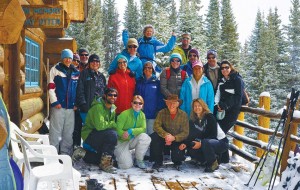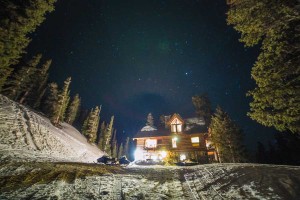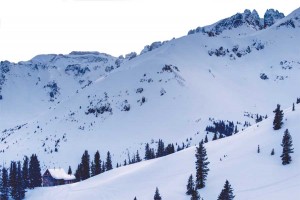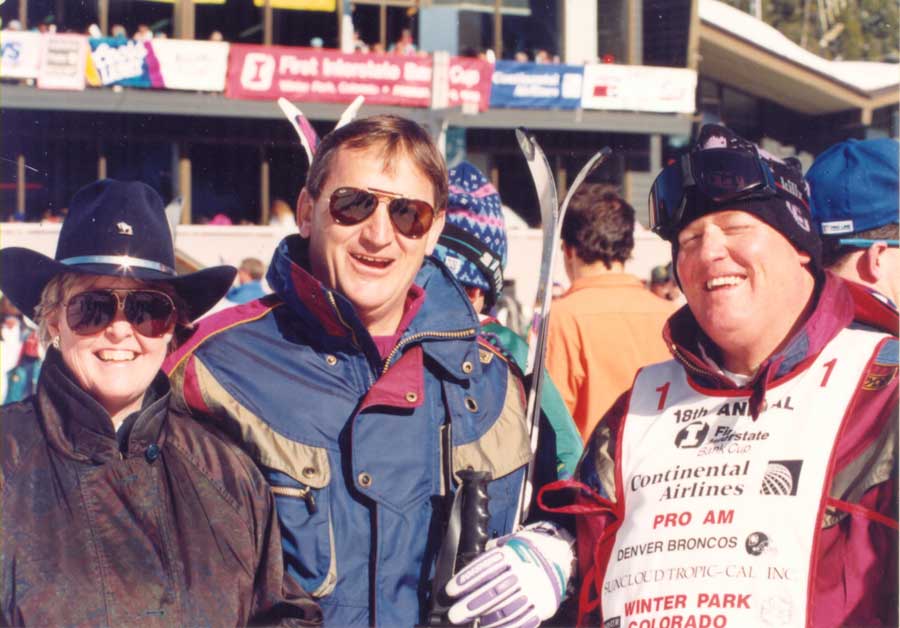Backcountry Hut Trips
04 Dec 2015
Escape the Ordinary
By Eli Wallace Spindrifts dance along a glittering bank under the sway of heavy-laden pines. The path ahead tracks through virgin snowfall. When you close your eyes, the only sound is the swish-swish-swish of nylon, your own tracks edging through the hushed wilderness. To be at once nearby and unfathomably far from everything—from the din of resorts and of I-70 and of the popular trails—this is the glory of a backcountry escape. And the experience isn’t so unreachable as it might seem.

Getting Started
Although hut trips offer plenty for beginners, it’s important to know the basics before heading out. If the main mode of transport is skiing, you should know how to stop and turn. For mountain-bike trips, be sure you know how to ride a bike and are comfortable going uphill and downhill on narrow singletrack. And if it’s a snowmobile trip, you’re probably best off using a guide company and renting the equipment. No matter what time of year it is, you’ll want to dress in multiple layers, preferably with the top layer being waterproof and the rest breathable. Especially for mountain bikers, that can help you weather the sudden storms and temperature changes that come with altitude. Both summer and winter adventurers will work up a sweat from the cardio they’re doing, whatever the temperature. “If you don’t know what you’re doing, talk with guides and outfitters. Local experts are often the best people to ask,” Lempit says. Once you feel that you’re ready, you’ll want to contact the hut.Tailored Trips
South and across to the West Slope, in the center of the Rockies, or just over the local ridgeline? The choice is yours—just decide how far away you really want to go, and there’s likely a hut in the area. Colorado has several large and popular hut systems, including the 10th Mountain Division huts (www.huts.org), comprising 34 huts in the central Rockies, many around Aspen, Vail and Breckenridge; the San Juan Hut System (www.sanjuanhuts.com), which offers unparalleled mountain biking in the Durango, Telluride and Moab areas, in addition to hiking and skiing huts; and The Summit Huts Association and The Grand Huts Association, smaller central-Rockies systems bookable through the 10th Mountain Division website. Closer to home, Never Summer Yurts (www.neversummernordic.com) opens the Never Summer mountains northwest of Rocky Mountain National Park to snowshoeing, cross-country skiing, snowmobiling and backcountry snowboarding in the winter, and mountain biking, fishing, horseback riding, hunting and mountaineering in the warmer months. Additionally, private huts like the Observatory at Alta Lakes (www.altalakes.com) and OPUS Hut (www.opushut.com), both near Telluride, stretch the believability of using the word “hut” to describe the lodgings. Think light packs while mountain biking through historic mining towns like Silverton and Rico, or huge, untouched ski fields dotted with alpine lakes in shades of impossible blue. You don’t have to carry as much on these luxury adventures, because they’ll feed you with locally grown, natural food when you arrive. Spend the evening watching DVDs, lounging on leather couches, or warming up tired muscles in the sauna. Other recommended private huts cut down on the splurge factor while still offering heaps of adventure, like the Hidden Treasure Yurt in Eagle County (www.backcountry-colorado-yurt.com), and the Pass Creek Yurt at Wolf Creek (www.wolfcreekbackcountry.com). Both of these huts offer beds, heaters and cooking utensils. Closest to home, the Colorado Mountain Club of Boulder (www.cmcboulder.org/cabins.html) operates two group cabins: the Brainard Cabin, west of Ward near Brainard Lake, and the Arestua Hut (aka Guinn Mountain Hut), south of Eldora Ski Resort and west of Lost Lake. Brainard is the larger of the two, sleeping 12 in communal floor areas and bunks, while Arestua offers a longer trail with more elevation gain and rustic, one-room accommodations for eight in the loft and on foam-padded benches. Beginner families may want to look into Brainard, as the trek is only 3 miles, with 600 feet in elevation gain.
Don’t Forget!
Packing lists and suggestions are widely available on hut websites, but there are a few items worth emphasizing. Sunscreen is a must, of course. In the winter, bring warm slippers for the cabin, as well as some toasty cabin socks to change into after a day’s hard work. The views will be unparalleled at any time of year, so bring extra batteries for your camera or an extra charge block for your phone and devices, like your GPS or GoPro. Find out ahead of time what kind of sleeping necessities you’ll need. Pillowcases and towels are often overlooked, so if you’re planning on showering and your hut doesn’t provide towels, consider buying an ultralight microfiber camping towel. Nobody likes carrying around extra weight, especially if it’s not useful. So try to pare down to the essentials in gadgetry and clothes. When it comes to packing food, choose lighter items, like pastas and dehydrated foods, and be sure to plan for the extra calories you’ll burn on the trail. If you’re going into the backcountry for more than just a few days, bring a few spices. They don’t add much weight or take up much room—and they’re a game changer for repetitive meals.Eli Wallace writes screenplays and magazine articles on food and feature topics. The rest of the time, she works for a Boulder Web development company.












